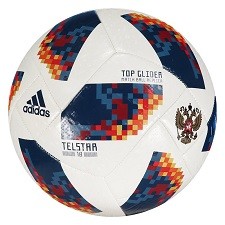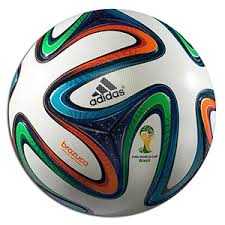FOOTBALL BALL SPECIFICATIONS: According to rules on the qualities and measurements of FIFA outdoor footballs, all balls must:
- Be spherical in shape and made of synthetic leather (or another suitable material).
- Have a circumference measuring not less than 68 cm (27 inches) and not more than 70 cm (28 inches) with a diameter of 22 cm (8.65 inches).
- Weigh not less than 410 grams (14 ounces) and be no heavier than 450 grams (16 ounces) at the beginning of the game.
- Have an internal pressure equal to 0.6 – 1.1 atmosphere (600 – 1,100 grams/cm2) at sea level (8.5 – 15.6 pounds per square inch).
Top players rely on consistent football equipment and facilities to perform at their best. The soccer ball is one of the mandatory pieces of equipment in the game. That is why strict regulations control the size and weight of a soccer ball.
Standard Soccer Ball Specification
| Numeric Value | Ball Type | Age Group | Circumference | Weight of Football |
|---|---|---|---|---|
| Ball Size 1 | Pee-Wee or Mini-Ball | A skills ball best for small kids | 45 – 51 cm (18 – 20 inches) | 205 grams |
| Ball Size 2 | Training | A skill ball best for kids around 4 | 52 – 56 cm (20 – 22 inches) | 210 – 280 grams |
| Ball Size 3 | Junior | Players of 8 years and under | 58 – 60 cm (23 – 24 inches) | 300 – 320 grams |
| Ball Size 4 | Youth | Players of 8 to 12 years old | 63 – 66 cm (25 – 26 inches) | 359 – 390 grams |
| Ball Size 5 | Adult | Players of 13 years and older | 69 – 71 cm (27 – 28 inches) | 410 – 450 grams |
Soccer Ball Technical Requirements
The regulations of official FIFA ball marks changed on the 31st of July 2017. They apply to matches played in any official competition organised under the auspices of FIFA or confederations.
As a result, all football balls must now bear one of the following FIFA quality marks:
- FIFA Quality PRO
- FIFA Quality
- IMS – INTERNATIONAL MATCH STANDARD
FIFA Law 2 [The Ball] stipulates the minimum standards on football ball specifications. The registered mark is a sign of official testing. It indicates that balls meet the specific technical requirements for that particular mark of quality.
Furthermore, the International Football Association Board (IFAB) must also approve the ball markings. Institutes that conduct the tests are also subject to the express approval of FIFA.
Football Balls with Integrated Technology
The use of goal line technology (GLT) has become commonplace in the modern game. Thus, all official balls must carry one of the listed quality marks if they have integrated technology.
Important: Soccer balls may also need to bear one of the listed quality marks when used in a national football association competition.
The rules for matches played in an official competition organised under the auspices of FIFA, the national football associations, or confederations, state that:
- There can be no form of commercial advertising on the ball. However, an exception applies for the logo or emblem of:
- The competition and the competition organiser.
- The authorised trademark of the manufacturer.
- The competition regulations may restrict the number of markings and the sizes.
What if a Soccer Ball Becomes Defective?
You can view the official guidelines to follow in the FIFA Rule Book (PDF version) if the match ball needs replacing during a game. Simply put, if the ball became defective (e.g. a burst or deflation):
- The first action taken by the match referee will be to stop the game.
- The match would restart using a replacement ball. As a rule, the official would ‘drop’ the new ball at the same spot where the original one became defective.
The match would restart if the ball malfunctions at a kick-off, a goal kick, a corner kick, free kick, throw-in, or a penalty kick.
A penalty is retaken if the ball becomes defective while kicking a spot kick. The same rule applies to kicks taken from the penalty mark as it moves forward – providing it does not make contact with another player, goalposts, or crossbar.
Note: In all cases, the soccer ball must not be changed during a match without the full authority of the referee.
The Use of Additional Balls
All extra footballs must meet the specification requirements of FIFA Law 2. The use of any additional balls, often placed around the field of play, also fall under the full control of the match referee.
 FIFA World Cup Football Balls
FIFA World Cup Football Balls
Without doubt, one of the premier events in World Football is the FIFA World Cup™. As such, FIFA have excelled in many parts of the game. Moreover, the design of the match ball is one of them.
Modern technology continues to influence association football – and many of its counterparts, not least in ball design and manufacture. The outcome is a better resistance to adverse weather and a consistent global performance.
ALSO IN THIS SECTION
A to Z List of Football Teams Names | An up-to-date listing of clubs, location, and stadium capacity.
Soccer Penalty Kicks | Find out how the new ‘ABBA’ system of sudden death penalties shootout works.
Adidas first began making soccer balls in 1963. They became the official match ball supplier when they produced the Telstar for the FIFA World Cup ball in 1970.
Adidas Official Match Ball
The Telstar ball had the Buckminster design. It was the first to have 32 black and white panels which helped it to be more visible on black and white televisions.
Adidas Brazuca Football
 Adidas sold approximately 13 million official World Cup match soccer balls in 2010. They made similar fortunes from the Brazuca ball a mere 4 years later.
Adidas sold approximately 13 million official World Cup match soccer balls in 2010. They made similar fortunes from the Brazuca ball a mere 4 years later.
The World Cup ‘Brazuca ball‘ cost around £100. Yet, the workers making it earned a little over £65 a month. It became the official match ball for the 2014 Soccer World Cup held in Brazil.
The Brazuca ball got voted in ‘publicly’ by more than one million football fans in the host country. Even so, it was manufactured and supplied by Forward Sports located in Sialkot, Pakistan.
Adidas Telstar 18
The official match ball used in the 2018 FIFA World Cup in Russia is Adidas Telstar 18. In general, it is a black and white patterned ball.
They named the pattern for its resemblance to the original Telstar communications satellite. In fact, the origins of the phrase combine the word ‘television’ with ‘star’.
The original Telstar ball had 32 panels. But, the Adidas Telstar 18 has six textured panels. Unlike earlier balls, the Telstar 18 is not stitched. Instead, the panels are ‘seamlessly’ glued together by the ball manufacturers in China and in Pakistan.
Note: The Adidas Telstar 18 is a unique soccer ball. It contains an embedded near-field communication chip or ‘NFC’. That means anyone who buys the ball gets interactivity thrown in for free.

